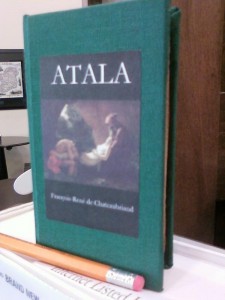It’s a little book and a little story as well. Not really long enough to be called a novel, the early work of Frenchman Francois-Rene de Chateaubriand had a basis in his travels in North America and his observations of the Native nations.
The volume in the image was recently rebound, and although the picture I selected for a front cover “paste down” illustration depicts a scene from the novella Atala, there are actually four stories in the book.
Originally written in 1801, the story had a significant impact on Romanticism and was adapted as a stage play as well as translated into several languages.
There are plenty of local interest facets: the story has its origins in a Seminole tale that survived by oral tradition. The narrator in the story lost his father in a battle with the Muscogee Nation, and the Cherokees also come into play later. Written well before the establishment of Indian Territory that became Oklahoma, the Native nations in Atala are still located in the South and Southeast.
Current reprints of the story contain a preface that explains that the author was in truth denouncing the idea of a “noble savage” – a literary device used in a number of works of that era. Such a character would possess attributes considered acceptable to “civilized” men, even though they came from an indigenous group that would have been disparaged at the time. His sympathetic depiction of two Native Americans was met with criticism by many of his early-19th-Century.
The issues of race and literature have changed somewhat in the last 211 years (195 years since this edition was published…) but in some respects the theme is as timely now as it was then – considering others for their merits rather than their race or religion.
This edition is somewhat scarce. A UK bookseller is offering one for £50 (roughly $80 US) and a single US vendor has a leather-bound copy listed for $70. The World Catalog shows six copies in libraries across the United States and ironically, five of the six are in locations with geographic ties to the one I just rebound. There are two in Texas, one at the University of Oklahoma, another at Kansas State University, and a fifth copy in Nebraska. The sixth listed volume is at the University of Mississippi. There are bound to be copies in private collections, but still, it is one of only a couple of hands-full still in existence.
I was happy to give it a cover that makes it presentable again and may last for another 200 years. (I’m glad I discovered what a scarce book it is – after the repairs were completed!)
